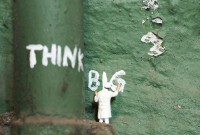- Home
- Business Processes
- Industry Knowledge
- Aerospace Industry
- Automotive Industry
- Banking Domain
- BFSI Industry
- Consumer/ FMCG Industry
- Chemicals Industry
- Engineering & Construction
- Energy Industry
- Education Domain
- Finance Domain
- Hospitality Domain
- Healthcare Industry
- Insurance Domain
- Retail Industry
- Travel and Tourism Domain
- Telecom Industry
- Leadership Skills
- eLearning
- Home
- Leadership
- Decision Making
- Generating Ideas using SCAMPER
Generating Ideas using SCAMPER
SCAMPER is an activity-based thinking process that can be performed by Cooperative learning. SCAMPER is an acronym that provides a structured way of assisting students to think out of the box and enhance their knowledge. This can be used in the organizational context as a technique for creative problem solving and as a toolkit to generate fresh ideas.
“Make it a habit to keep on the lookout for novel and interesting ideas that others have used successfully. Your idea needs to be original only in its adaptation to the problem you are working on”
- Thomas Edison
Origin of SCAMPER
SCAMPER was first proposed by Alex Faickney Osborn in 1953. This idea was further developed by Bob Eberle in his book; SCAMPER: Games for Imagination Development in 1971. This technique seeks to undertake seven-step checklist to arrive at new ideas. SCAMPER is based on the notion that everything new is a modification of something that already exists and hence this tool helps you generate ideas for new products and services by forcing you to think about how you could improve existing ones.
Meaning of SCAMPER
SCAMPER is thought to protect students' creativity as they mature. SCAMPER was originally used by teachers to assist the students in choosing a particular topic and then develop it further through a structured process. After choosing an idea, the students were given a checklist where they were asked to perform the activity in steps corresponding to the letters in the checklist. In the organization context, this could be used as a toolkit for creative problem solving and help you overcome any challenge that the group may be trying to solve. SCAMPER can be used as n Idea Manipulation Tool to generate diverse ideas. SCAMPER can be thought of as a generic checklist with idea-spurring questions which is quite easy to use and very effective in generating ideas. Given below are the ideas associated with each of the alphabets in the word SCAMPER:
- S = Substitute
- C = Combine
- A = Adapt
- M = Magnify
- P = Put to Other Uses
- E = Eliminate (or Minify)
- R = Rearrange (or Reverse)
Usage of SCAMPER Tool
SCAMPER is based on the notion that everything new is a modification of something that already exists and hence rather than promoting the group to focus on original ideas, this tool provides a way to gather diverse ideas from divergent fields and manipulate them into your requirements or problem statement. We start by dividing our problem into different tasks and asking SCAMPER questions at each step to generate ideas. Let’s look at these steps.
1. Substitute
Substitute comes up with another topic that is equivalent to the present topics. Substitute means to replace the problem, product, service, or process with something else. By looking for replacements or substitutes you can come up with new ideas that can change or improve the products, services, processes, systems, or people.
Helper Questions
- Can I replace or change any parts?
- Can I replace someone involved?
- Can I use other or materials?
- Can I use other processes or procedures?
- Can I substitute one part for another?
2. Combine
'C' stands for Combine which means can we mix, combine with other assemblies or services, or integrate. Combine adds information to the original topic. You could combine several ideas, processes or products into one more efficient output. An example of a combination of two different products is cell phones with an integrated camera.
Helper Questions
- What ideas or parts can be combined?
- Can I combine or merge it with other objects?
- What materials could be combined?
3. Adjust
'A' stands for Adapt/Alter which means can we adapt or alter, change function, use part of another element. Adjust identifies ways to construct the topic in a more flexible and adjusted material. Sometimes an idea that worked to solve one problem could also be used to solve a different problem. Netflix adapted to online streaming from being a DVD rental service.
Helper Questions
- What processes can be adapted?
- What different contexts can I put my concept in?
- What ideas outside my field can I incorporate?
4. Modify
- M' stands for Modify which means can we increase or reduce in scale, change shape, modify attributes. Modify magnify, minify creatively changes the topic, or makes a feature/idea bigger or smaller.
Helper Questions
- What can be modified?
- What can be made higher, bigger, or stronger?
- Can I increase its frequency?
- Can I add extra features or somehow add extra value?
5. Put to other Uses
P stands for Put to another use which means can we put this product to another user. This identifies the possible scenarios and situations where this topic can be used. Modify the intention of the subject. Think about why it exists, what it is used for, what it's supposed to do. Challenge all of these assumptions and suggest new and unusual purposes.
Helper Questions
- What else can it be used for?
- Are there other possible uses if it’s modified?
- Can I use this idea in other markets or industries?
6. Eliminate
'E' stands for Eliminate which means can we remove features and simplify. Eliminate removes ideas or elements from the topic that are not valuable. It’s about eliminating inefficient processes (‘waste’) with the goal of streamlining them.
Helper Questions
- How can I simplify it?
- What parts can be removed without altering its function?
- What’s non-essential or unnecessary?
- Should I split it into different parts?
7. Reverse
'R' stands for Rearrange or reverse, which means can we rearrange the features and see the results or can we tum reverse the order that is being followed now. Sometimes when you reverse the way a product is used; it will help you see things from a different perspective.
Helper Questions
- What other arrangements might be better?
- Can I interchange components?
- Are there other patterns, layouts, or sequences I can use?
- Should I turn it around? Up instead of down? Down instead of up?
- What if I consider it backward?
So, whenever a new product or service is to be launched or the existing one is to be improved, the SCAMPER technique uses these questions as a checklist, and suitable changes are adopted and implemented.
Related Links
You May Also Like
-
In our present Hitech scenario, society is changing very fast. What are the skills that are most relevant for leaders in relation to the changing economic environment? Leaders need to develop skills to drive innovation and change in order to play a more central role in their organizations’ activities. How do managers accept the change and meet business expectations by becoming a key figure in driving change and innovation?
-
Building Perfect Creative Team
One misconception around creativity is that creative act is essentially solitary. Most of the world's important inventions resulted not from the work of one lone genius, but from collaboration of a team with complementary skills. Managers should build teams with the ideal mix of traits to form a creative group and then establish the conditions that make creativity much more likely to occur.
-
In its simplest sense, decision-making is the act of choosing between two or more courses of action. Decision making is a key skill in the workplace and is particularly important if you want to be an effective leader. When decisions have to be made, there are several stages that you should go through to reach a practical solution. Understand the meaning and importance of decision making and how to look at it as a process.
-
A manager or an employee in an organization who is experiencing a high level of stress may develop high blood pressure, ulcers, irritability, difficulty in making routine decisions, loss of appetite, accident proneness, and the like. These can be subsumed under three general categories, physiological, psychological, and behavioral symptoms. Stress can give rise to a number of changes.
-
We define Lean as the systematic elimination of waste through a continual effort to decrease inefficiency; the lean leader strives to create a more efficient organization. Lean leadership is a philosophy. It is a consistent way of thinking and being in your role as a leader. The focus of this approach is on raising new leaders and help their team embrace a culture of continuous improvement. Learn what we mean by lean leadership style and its principles.
-
Creating Highly Effective Teams
How do we create effective teams? What comes to mind when you think about an effective team? High performing teams exhibit accountability, purpose, cohesiveness, and collaboration. It is a team that works seamlessly as a whole. Everyone brings unique talents and strengths and support each other to bring out the best in everyone. How do you create one?
-
Understanding Corporate Strategy
Management outlook and procedures have been revolutionized by more and more innovations over the recent years. It is no longer possible to follow traditional approaches to develop your organization's direction, its management as well its effectiveness. Senior managers need to be good decision-makers. In this section, we introduce concepts for strategy, strategic planning, strategic leadership, their exact meaning and associated terms, and how to use them.
-
Generating Ideas using Brainstorming
The brainstorming technique was developed by Alex F. Osborn in 1957 and brainstorming means where a team of members generates a large amount of alternative fruitful ideas on a specific problem without any criticism and then evaluates each idea in terms of their pros and cons. Brainstorming techniques fall into four broad categories: visioning, exploring, modifying, and experimenting.
-
Collaborative leadership is all about collaborative problem-solving and decision-making or can also be defined as the leadership of a collaborative effort. . The term started to appear in the mid-1990s in response to the formation of long term public-private partnerships to rebuild public infrastructure. Learn how you can use principles of collaborative leadership to enhance your leadership skills for being an effective leader.
-
Stress is a product of the busyness of modern life. It has assumed grave dimensions ever since the emergence of industrialism. In fact, stress is a natural, ongoing, dynamic, and interactive process that takes place as people adjust to their environment. Stress can be brought about by positive or negative life events. Distress can cause disease and eustress or positive stress can promote wellbeing and increased productivity. Learn to recognize and be responsible for your stress, and learn the ways to manage stress.
Explore Our Free Training Articles or
Sign Up to Start With Our eLearning Courses

About Us
Learning
© 2023 TechnoFunc, All Rights Reserved










